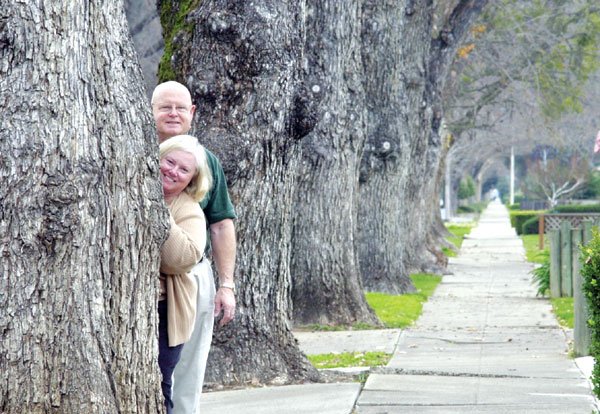GILROY
– A grassroots effort to design sidewalks in Gilroy big enough
to handle 50-foot tall landmark trees – like the ones lining Miller
Avenue and Fifth Street – is taking root.
GILROY – A grassroots effort to design sidewalks in Gilroy big enough to handle 50-foot tall landmark trees – like the ones lining Miller Avenue and Fifth Street – is taking root.
Two members of the city’s Parks and Recreation Commission are asking the city to design more traditional tree-lined streets of the 1940s and 1950s variety, rather than the cement-heavy neighborhoods made common over the past few decades. Phil Buchanan and Sherri Stuart say the likely costs associated with more tree-lined streets will be well worth the benefits – cooler, slower-traveled, friendlier and, above all, prettier neighborhoods.
“See how you feel when you drive down Miller and Fifth and compare that to how you feel when you drive up Third (Street) or somewhere in the northwest quad,” Buchanan said. “Which streets are you more proud of?”
Buchanan used this same matter-of-fact approach in front of City Council Monday as he made a presentation complete with photos of tree-lined and tree-vacant streets. He urged Councilmen to encourage developments that create so-called park strips – often a 10-foot-wide patch of grass between street and sidewalk – where decades-old, several-foot-wide, 50-foot-high trees grow, creating canopies above the roadway.
“We’re talking about special trees of some magnitude that give a neighborhood a special atmosphere,” Buchanan said.
Although all new developments must plant trees around properties, most neighborhoods these days are built with so-called monolithic sidewalks which connect to curb and street without a landscaped park strip in between. There is also no law requiring developers to plant more mature – more costly – trees. Under zoning law, a seedling a few feet high is no different than a 100-year-old oak.
Buchanan, who lives in an already tree-lined neighborhood at Fifth and Miller, ended his presentation by asking Council to consider setting up a task force – comprised of developers, home owners, arborists and various city officials – to study other tree-friendly city’s laws.
City Council unanimously agreed to consider whether to form the task force during its Jan. 16-17 retreat.
“I applaud your efforts, and I think your heart’s in the right place in trying to bring a sense of beauty to the community,” Councilman Charlie Morales told Buchanan Monday night.
How the law might work
Last year, San Jose’s City Council was praised by The Mercury News editorial board for updating its tree ordinance. The city now requires, in most instances, one tree to be planted in front of each new and existing home. If a home with no tree is sold, the new owners are responsible for planting a minimum 15-gallon tree (usually 6 feet tall depending on the species).
“It won’t make an overnight difference, but in a number of years it will contribute to better quality neighborhoods,” said Rick Mize, the city arborist for San Jose.
Mize said San Jose has a program to donate trees to homeowners who cannot afford to buy one.
“We’ve had no problem with the law (which has been on the books since March),” Mize said. “We’ve had lots of calls from Realtors, though.”
Realtors, Mize said, largely supported the ordinance because in some cases, home prices increase by $20,000 when a street is tree-lined.
The city’s task force – if Council forms one – would have to examine how far to take the law in Gilroy.
The task force could, for instance, use the San Jose format, or it could recommend grandfathering all existing developments so the city can focus only on creating park strips with trees on the sidewalks of new neighborhoods.
City Planning Division Manager Bill Faus said under Gilroy’s current system the number and maturity of trees planted on major arterials is greater than on regular side streets.
“What I hear Phil (Buchanan) asking for (on all streets) is what we do only for major arterials and collectors now,” Faus said.
Even if the city moves toward more park strips and tree-lined streets Faus said Gilroyans will still have to wait decades to see the effect.
“Some of this is a product of our fast-paced world,” Faus said. “Those big oak trees take a multitude of decades to get the point where there is a fully wooded canopy of trees.”
Where did all the trees go?
Stuart, the other Parks and Recreation Commissioner, says there are several theories on why tree-lined streets seem to be a thing of the past.
Stuart said she’s been told by historians that Henry Miller, Gilroy’s famed land and cattle baron of the mid 1800s, planted the trees along Miller Avenue to mark his cattle route.
“Air conditioning,” Stuart said is the basis of another theory. “The need for a shady street wasn’t as important once air conditioners became more standard.”
But Stuart and Buchanan believe tree-lined streets do more than keep homes cool; they say the trees bring neighborhoods together, inspire people to take walks and give drivers the sense of a small road, causing them to drive more slowly.
“It’s funny how the trees sort of act as catalysts,” Buchanan said. “Fifth Street has some of the best trees, and that’s probably the most united street in town. They have block parties, they have Christmas parties where they decorate the trees … ”
As for the disappearance of tree-lined streets, the correct question to ask is where all the park strips went, says Carla Ruigh, the city’s operations services manager.
On easements around new homes, young saplings are taking root all over Gilroy. But, Ruigh says, land costs inspire developers to build more houses on smaller lots, making the tree-packed park strip a luxury of the past.
“The number-one reason for less park strips is the rising cost of land,” Ruigh said.
Tree-lined streets, Ruigh said, have their share of other issues, too. Trees drop leaves which have to be picked up by city crews before they clog storm drains.
Tree roots are also notorious for lifting up sidewalks, causing more work for already overburdened city crews.
The city employs two-full time staff to maintain Gilroy’s urban forest.
Buchanan and Stuart acknowledge myriad issues triggered by tree-lined streets, but they say the task force could help the city find solutions.
There are many species of trees that grow deeper roots less likely to lift up sidewalks. Also, new soils used underneath sidewalks are being designed to keep roots away from the concrete.
Buchanan and Stuart said the city may be able to fund some of the increase in maintenance costs by using the increase in property tax values from the additional tree-lined streets.
“There’s a whole ripple effect that could come out of this,” Stuart said. “We need to at least look into it.”














